Finance Case Study: Strategic Implications of Bud and InBev M&A
VerifiedAdded on 2022/09/05
|7
|1638
|20
Case Study
AI Summary
This case study analyzes the strategic and financial implications of the merger and acquisition (M&A) between Budweiser (Anheuser-Busch) and InBev. The analysis begins by assessing the strategic rationale for the merger, highlighting the competitive dynamics in the American market and InBev's goal to become a global beer leader. The study then delves into the valuation aspects, including the price InBev should be willing to pay for Anheuser-Busch shares, considering different scenarios and potential revenue synergies. Sensitivity analyses are performed to identify key factors affecting the price. The case also explores the options available to August Busch IV in response to InBev's public bid, such as cost reduction and share repurchase programs. Finally, the document provides a valuation of the company as of December 31, 2007, and the factors that affect the price in the M&A including asset sales, stock sales and the strategic rationale for this merger. The case study references relevant academic literature to support its arguments.
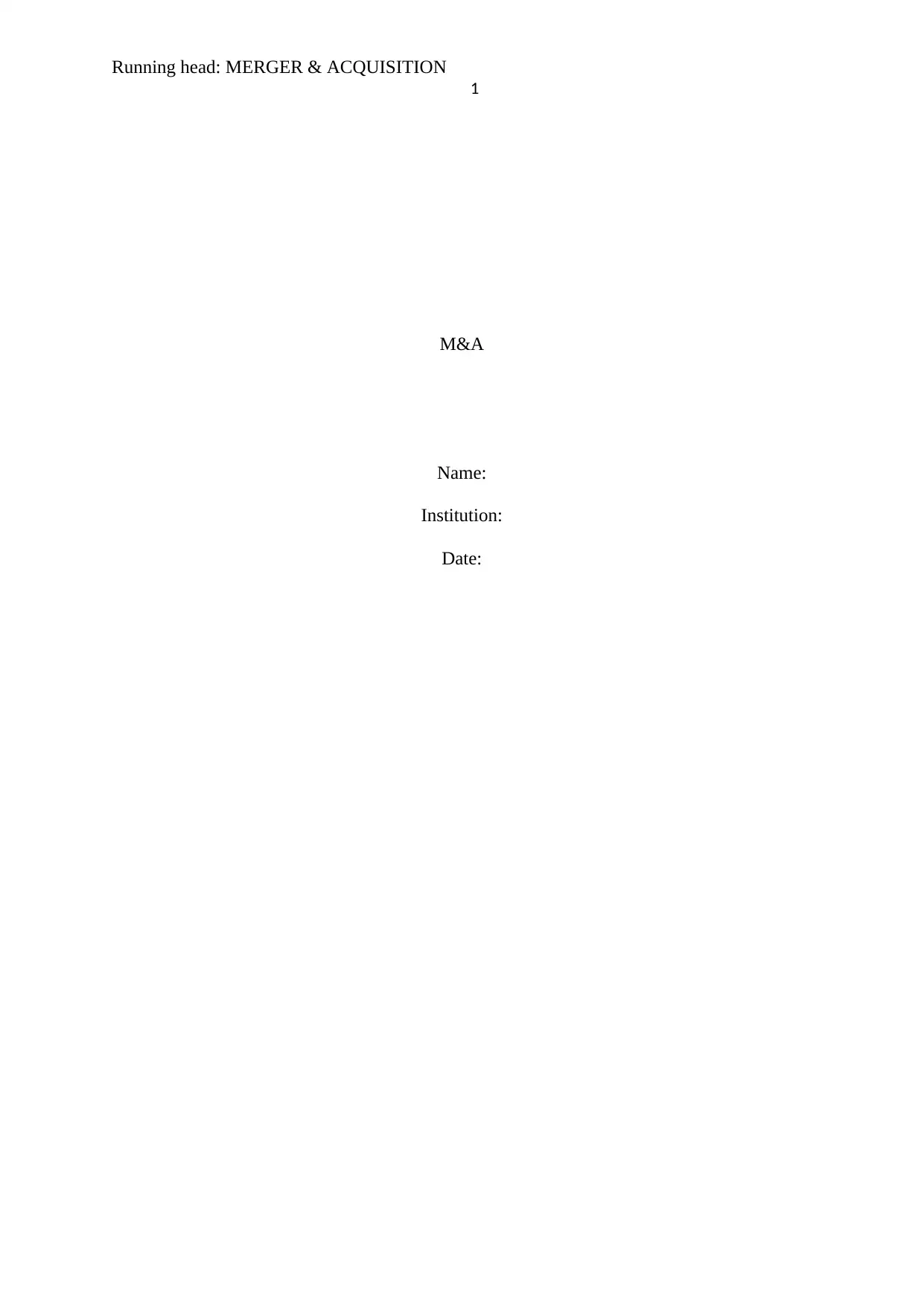
Running head: MERGER & ACQUISITION
1
M&A
Name:
Institution:
Date:
1
M&A
Name:
Institution:
Date:
Paraphrase This Document
Need a fresh take? Get an instant paraphrase of this document with our AI Paraphraser
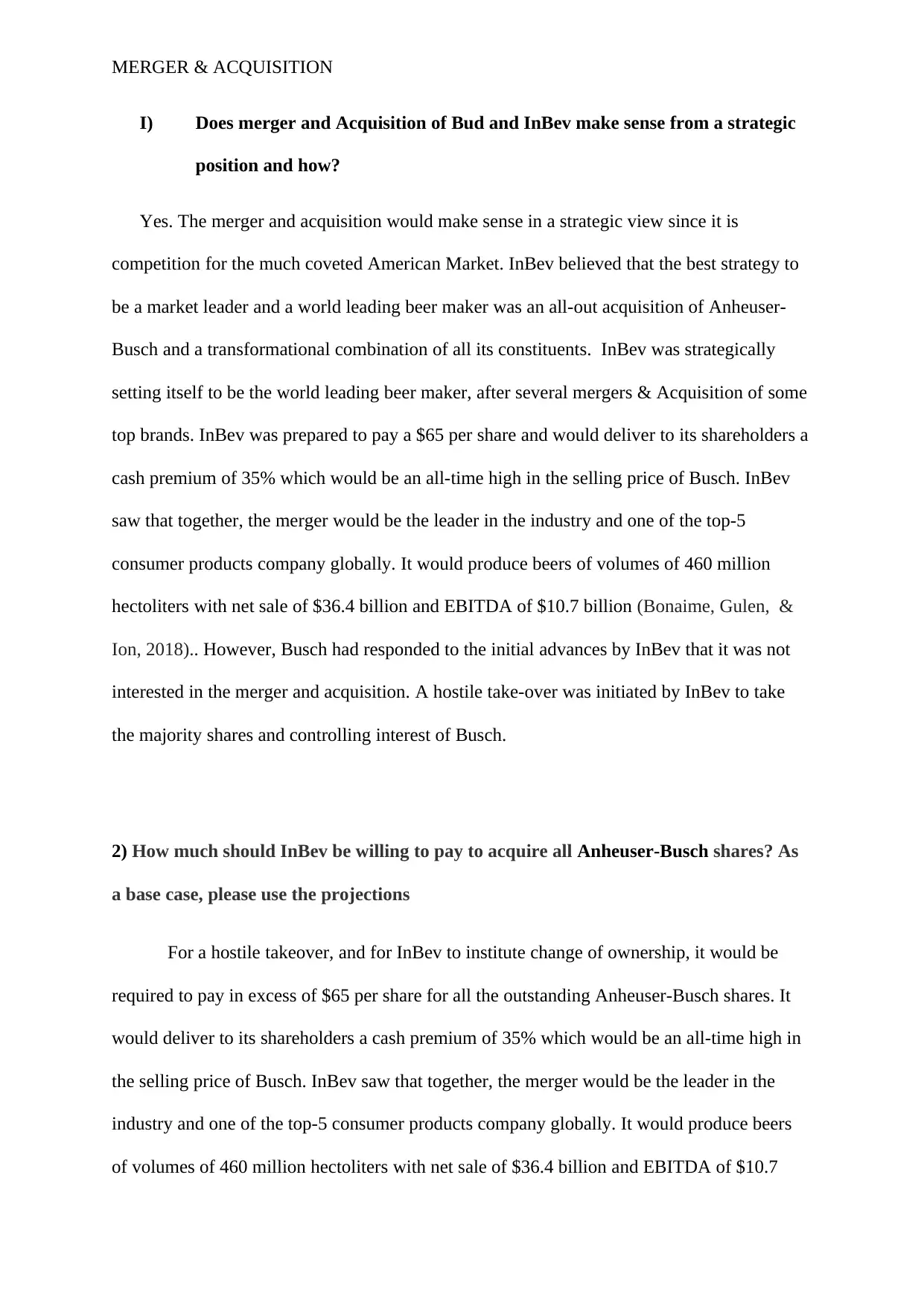
MERGER & ACQUISITION
I) Does merger and Acquisition of Bud and InBev make sense from a strategic
position and how?
Yes. The merger and acquisition would make sense in a strategic view since it is
competition for the much coveted American Market. InBev believed that the best strategy to
be a market leader and a world leading beer maker was an all-out acquisition of Anheuser-
Busch and a transformational combination of all its constituents. InBev was strategically
setting itself to be the world leading beer maker, after several mergers & Acquisition of some
top brands. InBev was prepared to pay a $65 per share and would deliver to its shareholders a
cash premium of 35% which would be an all-time high in the selling price of Busch. InBev
saw that together, the merger would be the leader in the industry and one of the top-5
consumer products company globally. It would produce beers of volumes of 460 million
hectoliters with net sale of $36.4 billion and EBITDA of $10.7 billion (Bonaime, Gulen, &
Ion, 2018).. However, Busch had responded to the initial advances by InBev that it was not
interested in the merger and acquisition. A hostile take-over was initiated by InBev to take
the majority shares and controlling interest of Busch.
2) How much should InBev be willing to pay to acquire all Anheuser-Busch shares? As
a base case, please use the projections
For a hostile takeover, and for InBev to institute change of ownership, it would be
required to pay in excess of $65 per share for all the outstanding Anheuser-Busch shares. It
would deliver to its shareholders a cash premium of 35% which would be an all-time high in
the selling price of Busch. InBev saw that together, the merger would be the leader in the
industry and one of the top-5 consumer products company globally. It would produce beers
of volumes of 460 million hectoliters with net sale of $36.4 billion and EBITDA of $10.7
I) Does merger and Acquisition of Bud and InBev make sense from a strategic
position and how?
Yes. The merger and acquisition would make sense in a strategic view since it is
competition for the much coveted American Market. InBev believed that the best strategy to
be a market leader and a world leading beer maker was an all-out acquisition of Anheuser-
Busch and a transformational combination of all its constituents. InBev was strategically
setting itself to be the world leading beer maker, after several mergers & Acquisition of some
top brands. InBev was prepared to pay a $65 per share and would deliver to its shareholders a
cash premium of 35% which would be an all-time high in the selling price of Busch. InBev
saw that together, the merger would be the leader in the industry and one of the top-5
consumer products company globally. It would produce beers of volumes of 460 million
hectoliters with net sale of $36.4 billion and EBITDA of $10.7 billion (Bonaime, Gulen, &
Ion, 2018).. However, Busch had responded to the initial advances by InBev that it was not
interested in the merger and acquisition. A hostile take-over was initiated by InBev to take
the majority shares and controlling interest of Busch.
2) How much should InBev be willing to pay to acquire all Anheuser-Busch shares? As
a base case, please use the projections
For a hostile takeover, and for InBev to institute change of ownership, it would be
required to pay in excess of $65 per share for all the outstanding Anheuser-Busch shares. It
would deliver to its shareholders a cash premium of 35% which would be an all-time high in
the selling price of Busch. InBev saw that together, the merger would be the leader in the
industry and one of the top-5 consumer products company globally. It would produce beers
of volumes of 460 million hectoliters with net sale of $36.4 billion and EBITDA of $10.7
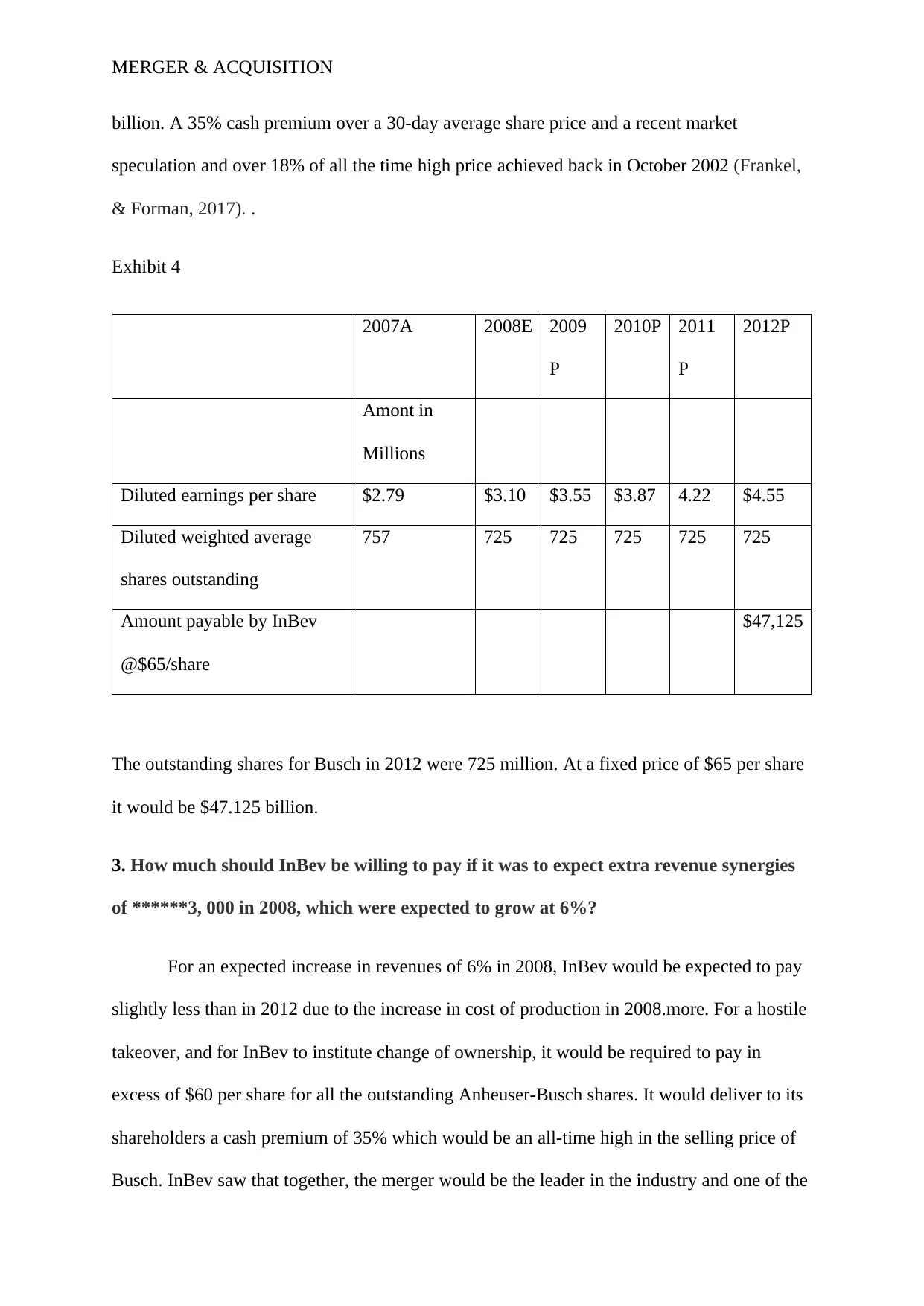
MERGER & ACQUISITION
billion. A 35% cash premium over a 30-day average share price and a recent market
speculation and over 18% of all the time high price achieved back in October 2002 (Frankel,
& Forman, 2017). .
Exhibit 4
2007A 2008E 2009
P
2010P 2011
P
2012P
Amont in
Millions
Diluted earnings per share $2.79 $3.10 $3.55 $3.87 4.22 $4.55
Diluted weighted average
shares outstanding
757 725 725 725 725 725
Amount payable by InBev
@$65/share
$47,125
The outstanding shares for Busch in 2012 were 725 million. At a fixed price of $65 per share
it would be $47.125 billion.
3. How much should InBev be willing to pay if it was to expect extra revenue synergies
of ******3, 000 in 2008, which were expected to grow at 6%?
For an expected increase in revenues of 6% in 2008, InBev would be expected to pay
slightly less than in 2012 due to the increase in cost of production in 2008.more. For a hostile
takeover, and for InBev to institute change of ownership, it would be required to pay in
excess of $60 per share for all the outstanding Anheuser-Busch shares. It would deliver to its
shareholders a cash premium of 35% which would be an all-time high in the selling price of
Busch. InBev saw that together, the merger would be the leader in the industry and one of the
billion. A 35% cash premium over a 30-day average share price and a recent market
speculation and over 18% of all the time high price achieved back in October 2002 (Frankel,
& Forman, 2017). .
Exhibit 4
2007A 2008E 2009
P
2010P 2011
P
2012P
Amont in
Millions
Diluted earnings per share $2.79 $3.10 $3.55 $3.87 4.22 $4.55
Diluted weighted average
shares outstanding
757 725 725 725 725 725
Amount payable by InBev
@$65/share
$47,125
The outstanding shares for Busch in 2012 were 725 million. At a fixed price of $65 per share
it would be $47.125 billion.
3. How much should InBev be willing to pay if it was to expect extra revenue synergies
of ******3, 000 in 2008, which were expected to grow at 6%?
For an expected increase in revenues of 6% in 2008, InBev would be expected to pay
slightly less than in 2012 due to the increase in cost of production in 2008.more. For a hostile
takeover, and for InBev to institute change of ownership, it would be required to pay in
excess of $60 per share for all the outstanding Anheuser-Busch shares. It would deliver to its
shareholders a cash premium of 35% which would be an all-time high in the selling price of
Busch. InBev saw that together, the merger would be the leader in the industry and one of the
⊘ This is a preview!⊘
Do you want full access?
Subscribe today to unlock all pages.

Trusted by 1+ million students worldwide
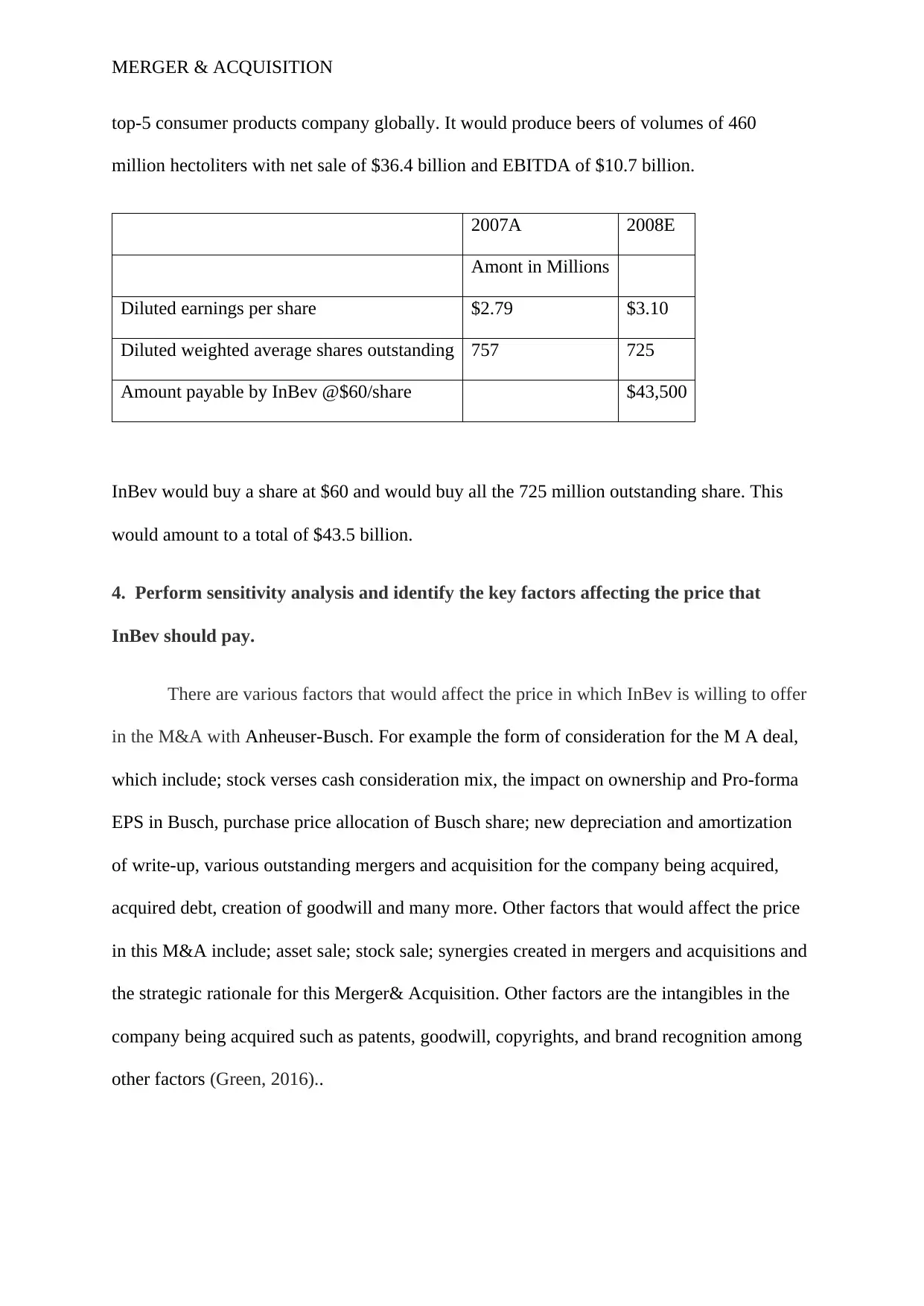
MERGER & ACQUISITION
top-5 consumer products company globally. It would produce beers of volumes of 460
million hectoliters with net sale of $36.4 billion and EBITDA of $10.7 billion.
2007A 2008E
Amont in Millions
Diluted earnings per share $2.79 $3.10
Diluted weighted average shares outstanding 757 725
Amount payable by InBev @$60/share $43,500
InBev would buy a share at $60 and would buy all the 725 million outstanding share. This
would amount to a total of $43.5 billion.
4. Perform sensitivity analysis and identify the key factors affecting the price that
InBev should pay.
There are various factors that would affect the price in which InBev is willing to offer
in the M&A with Anheuser-Busch. For example the form of consideration for the M A deal,
which include; stock verses cash consideration mix, the impact on ownership and Pro-forma
EPS in Busch, purchase price allocation of Busch share; new depreciation and amortization
of write-up, various outstanding mergers and acquisition for the company being acquired,
acquired debt, creation of goodwill and many more. Other factors that would affect the price
in this M&A include; asset sale; stock sale; synergies created in mergers and acquisitions and
the strategic rationale for this Merger& Acquisition. Other factors are the intangibles in the
company being acquired such as patents, goodwill, copyrights, and brand recognition among
other factors (Green, 2016)..
top-5 consumer products company globally. It would produce beers of volumes of 460
million hectoliters with net sale of $36.4 billion and EBITDA of $10.7 billion.
2007A 2008E
Amont in Millions
Diluted earnings per share $2.79 $3.10
Diluted weighted average shares outstanding 757 725
Amount payable by InBev @$60/share $43,500
InBev would buy a share at $60 and would buy all the 725 million outstanding share. This
would amount to a total of $43.5 billion.
4. Perform sensitivity analysis and identify the key factors affecting the price that
InBev should pay.
There are various factors that would affect the price in which InBev is willing to offer
in the M&A with Anheuser-Busch. For example the form of consideration for the M A deal,
which include; stock verses cash consideration mix, the impact on ownership and Pro-forma
EPS in Busch, purchase price allocation of Busch share; new depreciation and amortization
of write-up, various outstanding mergers and acquisition for the company being acquired,
acquired debt, creation of goodwill and many more. Other factors that would affect the price
in this M&A include; asset sale; stock sale; synergies created in mergers and acquisitions and
the strategic rationale for this Merger& Acquisition. Other factors are the intangibles in the
company being acquired such as patents, goodwill, copyrights, and brand recognition among
other factors (Green, 2016)..
Paraphrase This Document
Need a fresh take? Get an instant paraphrase of this document with our AI Paraphraser
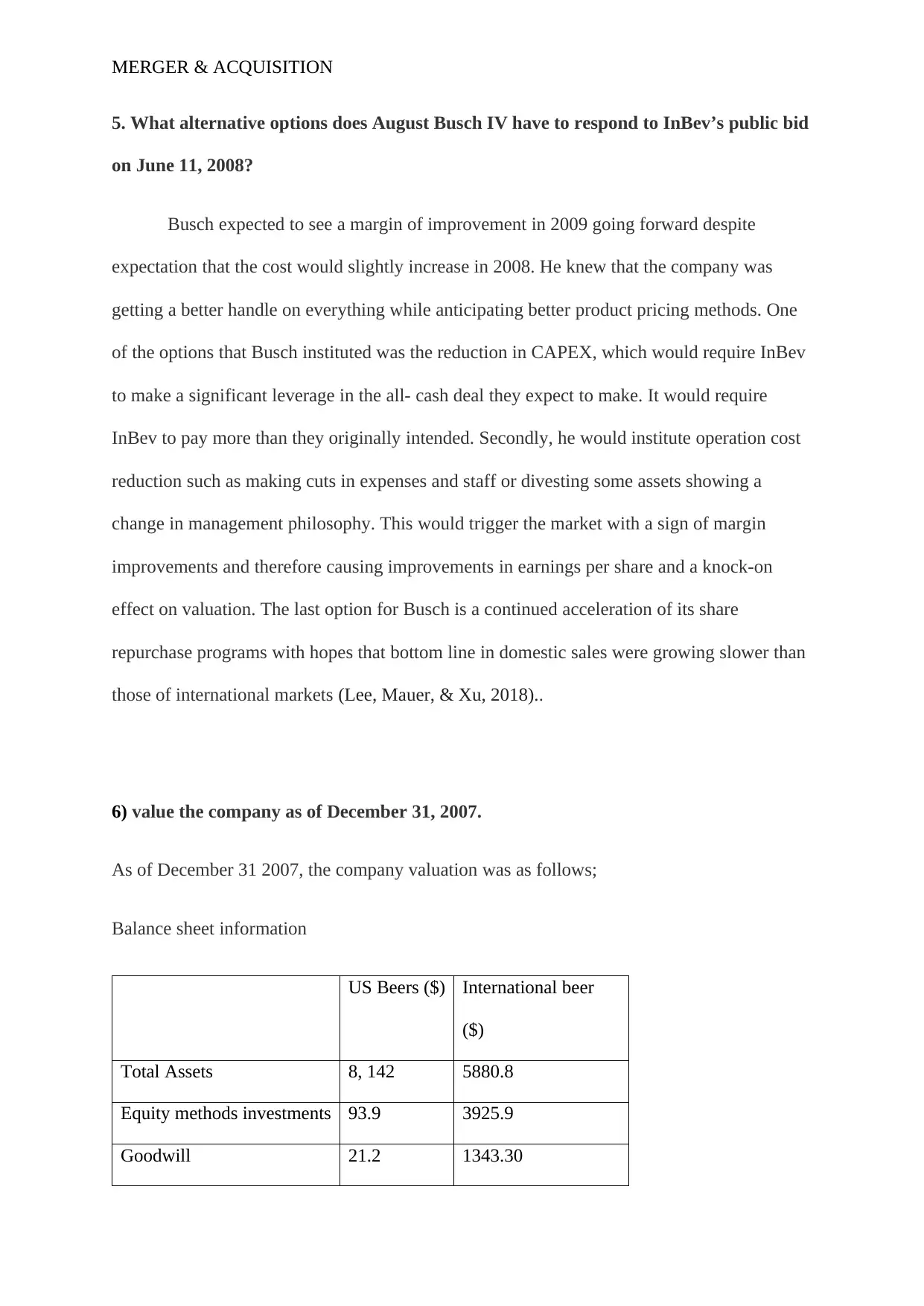
MERGER & ACQUISITION
5. What alternative options does August Busch IV have to respond to InBev’s public bid
on June 11, 2008?
Busch expected to see a margin of improvement in 2009 going forward despite
expectation that the cost would slightly increase in 2008. He knew that the company was
getting a better handle on everything while anticipating better product pricing methods. One
of the options that Busch instituted was the reduction in CAPEX, which would require InBev
to make a significant leverage in the all- cash deal they expect to make. It would require
InBev to pay more than they originally intended. Secondly, he would institute operation cost
reduction such as making cuts in expenses and staff or divesting some assets showing a
change in management philosophy. This would trigger the market with a sign of margin
improvements and therefore causing improvements in earnings per share and a knock-on
effect on valuation. The last option for Busch is a continued acceleration of its share
repurchase programs with hopes that bottom line in domestic sales were growing slower than
those of international markets (Lee, Mauer, & Xu, 2018)..
6) value the company as of December 31, 2007.
As of December 31 2007, the company valuation was as follows;
Balance sheet information
US Beers ($) International beer
($)
Total Assets 8, 142 5880.8
Equity methods investments 93.9 3925.9
Goodwill 21.2 1343.30
5. What alternative options does August Busch IV have to respond to InBev’s public bid
on June 11, 2008?
Busch expected to see a margin of improvement in 2009 going forward despite
expectation that the cost would slightly increase in 2008. He knew that the company was
getting a better handle on everything while anticipating better product pricing methods. One
of the options that Busch instituted was the reduction in CAPEX, which would require InBev
to make a significant leverage in the all- cash deal they expect to make. It would require
InBev to pay more than they originally intended. Secondly, he would institute operation cost
reduction such as making cuts in expenses and staff or divesting some assets showing a
change in management philosophy. This would trigger the market with a sign of margin
improvements and therefore causing improvements in earnings per share and a knock-on
effect on valuation. The last option for Busch is a continued acceleration of its share
repurchase programs with hopes that bottom line in domestic sales were growing slower than
those of international markets (Lee, Mauer, & Xu, 2018)..
6) value the company as of December 31, 2007.
As of December 31 2007, the company valuation was as follows;
Balance sheet information
US Beers ($) International beer
($)
Total Assets 8, 142 5880.8
Equity methods investments 93.9 3925.9
Goodwill 21.2 1343.30
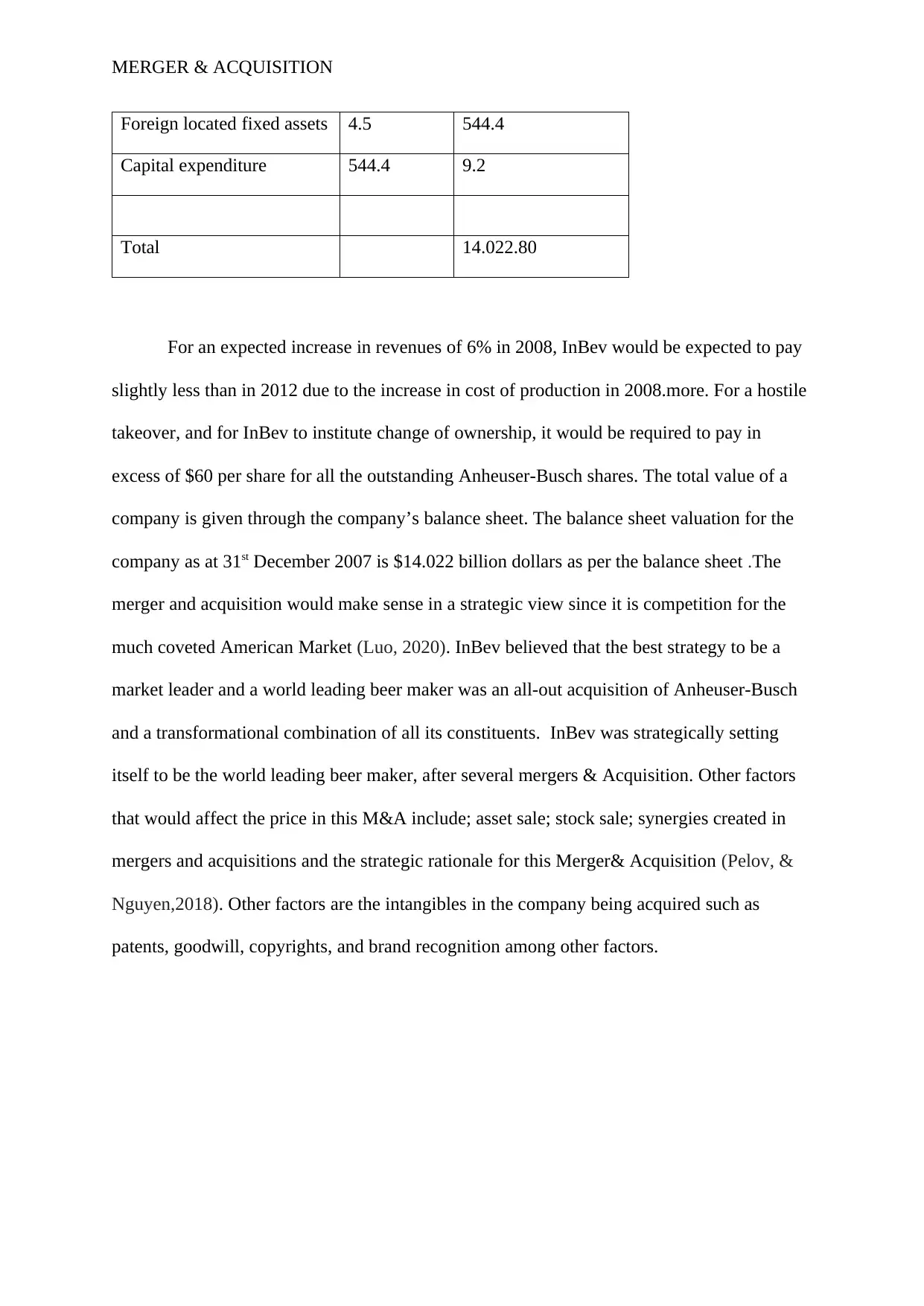
MERGER & ACQUISITION
Foreign located fixed assets 4.5 544.4
Capital expenditure 544.4 9.2
Total 14.022.80
For an expected increase in revenues of 6% in 2008, InBev would be expected to pay
slightly less than in 2012 due to the increase in cost of production in 2008.more. For a hostile
takeover, and for InBev to institute change of ownership, it would be required to pay in
excess of $60 per share for all the outstanding Anheuser-Busch shares. The total value of a
company is given through the company’s balance sheet. The balance sheet valuation for the
company as at 31st December 2007 is $14.022 billion dollars as per the balance sheet .The
merger and acquisition would make sense in a strategic view since it is competition for the
much coveted American Market (Luo, 2020). InBev believed that the best strategy to be a
market leader and a world leading beer maker was an all-out acquisition of Anheuser-Busch
and a transformational combination of all its constituents. InBev was strategically setting
itself to be the world leading beer maker, after several mergers & Acquisition. Other factors
that would affect the price in this M&A include; asset sale; stock sale; synergies created in
mergers and acquisitions and the strategic rationale for this Merger& Acquisition (Pelov, &
Nguyen,2018). Other factors are the intangibles in the company being acquired such as
patents, goodwill, copyrights, and brand recognition among other factors.
Foreign located fixed assets 4.5 544.4
Capital expenditure 544.4 9.2
Total 14.022.80
For an expected increase in revenues of 6% in 2008, InBev would be expected to pay
slightly less than in 2012 due to the increase in cost of production in 2008.more. For a hostile
takeover, and for InBev to institute change of ownership, it would be required to pay in
excess of $60 per share for all the outstanding Anheuser-Busch shares. The total value of a
company is given through the company’s balance sheet. The balance sheet valuation for the
company as at 31st December 2007 is $14.022 billion dollars as per the balance sheet .The
merger and acquisition would make sense in a strategic view since it is competition for the
much coveted American Market (Luo, 2020). InBev believed that the best strategy to be a
market leader and a world leading beer maker was an all-out acquisition of Anheuser-Busch
and a transformational combination of all its constituents. InBev was strategically setting
itself to be the world leading beer maker, after several mergers & Acquisition. Other factors
that would affect the price in this M&A include; asset sale; stock sale; synergies created in
mergers and acquisitions and the strategic rationale for this Merger& Acquisition (Pelov, &
Nguyen,2018). Other factors are the intangibles in the company being acquired such as
patents, goodwill, copyrights, and brand recognition among other factors.
⊘ This is a preview!⊘
Do you want full access?
Subscribe today to unlock all pages.

Trusted by 1+ million students worldwide

MERGER & ACQUISITION
References
Bonaime, A., Gulen, H., & Ion, M. (2018). Does policy uncertainty affect mergers and
acquisitions?. Journal of Financial Economics, 129(3), 531-558.
Frankel, M. E., & Forman, L. H. (2017). Mergers and acquisitions basics: the key steps of
acquisitions, divestitures, and investments. John Wiley & Sons.
Green, M. B. (2016). Mergers and acquisitions. International Encyclopedia of Geography:
People, the Earth, Environment and Technology, 1-9.
Lee, K. H., Mauer, D. C., & Xu, E. Q. (2018). Human capital relatedness and mergers and
acquisitions. Journal of financial Economics, 129(1), 111-135.
Luo, Y. (2020, February). Do China’s Manufacturing Cross-Border Mergers and Acquisitions
Enhance Its Management Innovation Capabilities?. In International Academic
Conference on Frontiers in Social Sciences and Management Innovation (IAFSM
2019) (pp. 421-425). Atlantis Press.
Pelov, S., & Nguyen, H. H. (2018). Distressed Mergers and Acquisitions.
References
Bonaime, A., Gulen, H., & Ion, M. (2018). Does policy uncertainty affect mergers and
acquisitions?. Journal of Financial Economics, 129(3), 531-558.
Frankel, M. E., & Forman, L. H. (2017). Mergers and acquisitions basics: the key steps of
acquisitions, divestitures, and investments. John Wiley & Sons.
Green, M. B. (2016). Mergers and acquisitions. International Encyclopedia of Geography:
People, the Earth, Environment and Technology, 1-9.
Lee, K. H., Mauer, D. C., & Xu, E. Q. (2018). Human capital relatedness and mergers and
acquisitions. Journal of financial Economics, 129(1), 111-135.
Luo, Y. (2020, February). Do China’s Manufacturing Cross-Border Mergers and Acquisitions
Enhance Its Management Innovation Capabilities?. In International Academic
Conference on Frontiers in Social Sciences and Management Innovation (IAFSM
2019) (pp. 421-425). Atlantis Press.
Pelov, S., & Nguyen, H. H. (2018). Distressed Mergers and Acquisitions.
1 out of 7
Your All-in-One AI-Powered Toolkit for Academic Success.
+13062052269
info@desklib.com
Available 24*7 on WhatsApp / Email
![[object Object]](/_next/static/media/star-bottom.7253800d.svg)
Unlock your academic potential
Copyright © 2020–2025 A2Z Services. All Rights Reserved. Developed and managed by ZUCOL.